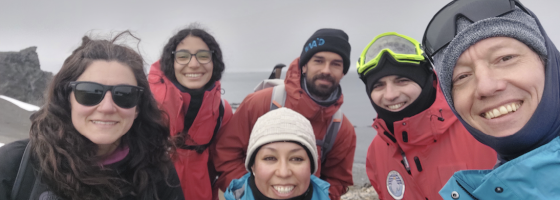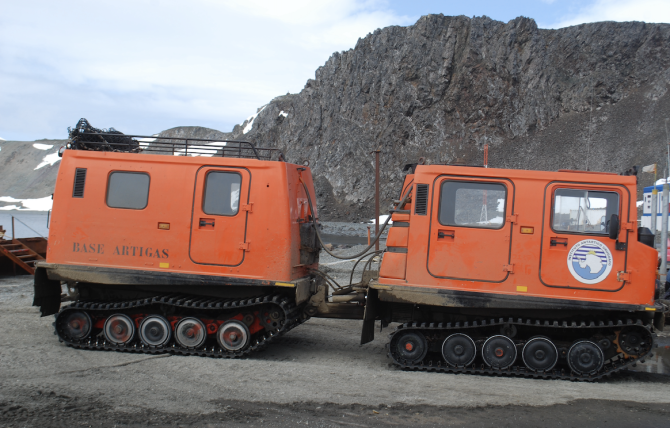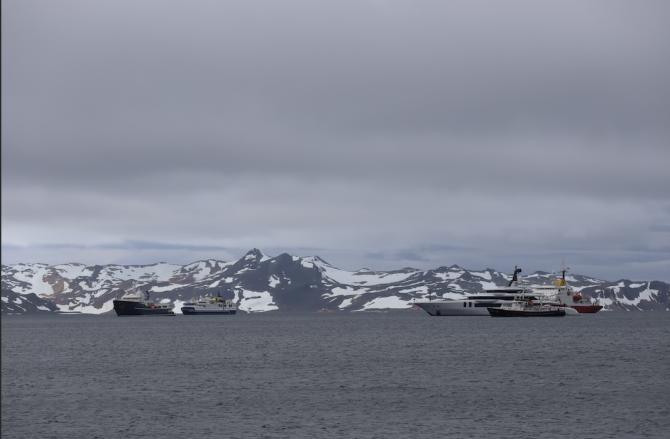Blog post
Antarctica Blog 3: Is collaboration everything?
Machiel Lamers and Daniela Cajiao are ENP researchers undertaking a scientific expedition to Antarctica in the context of the ANTARC-SHIP project. Their expedition takes place from mid-December 2023 until the end of January 2024. Stay tuned with this blog to hear the latest research updates, stories and adventures coming out of Antarctica!

Is collaboration everything?
If there is one thing that has become clear in the two weeks that we have been here, it is that collaboration is very important in Antarctica. Every day we observe acts of collaboration or hear about its importance for achieving the various objectives of different groups on this island with multiple scientific stations and limited resources. Researchers here (image above) are frequently helping each other out. Take for example, when researchers would replace the batteries of monitoring devices for research groups who have already left the island.
Stations may also share or trade food sources or other resources in case there is a shortage or a surplus. Generally, there is a great sense of friendliness, community and comradery. Moreover, stations may have different equipment or means of transportation, and can request for help in case there is a need to. For example, if the transportation route on the island is not yet suitable for accessing the Artigas station or undertaking work on this part of the Fildes Peninsula with regular 4x4 vehicles, others may request help from the Uruguay “Hagglunds”, a Swedish built caterpillar transportation vehicle designed for transportation across glaciers and rough terrain (image below).

Reducing impact and mutual benefits
Collaboration among scientists and logistical personnel also helps to reduce the impact that scientific activities may have on the island. Groups of researchers from different stations on the Fildes Peninsula may be interested in undertaking similar work, like monitoring the penguins, seabirds and seals on the island. Coordination of monitoring efforts and sharing of data is important to reduce the disturbance for the animals and minimize the impact on delicate flora, like mosses and lichens. Still, more of this coordination can be done. This year there is also the additional risk for the spreading of the avian flu pandemic among birds and marine mammals. Will every individual and programme on the island do everything possible to avoid the spreading of the virus—keeping a minimum of 15 meters distance from animals and disinfecting boots and gear after visits to beaches and other critical areas? We can only hope so.
There is also collaboration between logistical and tourism operations, leading to mutual benefits and potentially raising awareness and reducing impact. For example, the Artigas station area is used by a tourism logistics operator to temporary store equipment for a group of US students undertaking leadership trainings on the glacier adjacent to the station. The tourism sector is increasingly providing opportunities for scientists to join their journeys to collect critical data in areas that national scientific programmes would not have the means to visit, for example, for monitoring changing wildlife populations due to climate change. But how useful is the data collected from tourist vessels for generating scientific insights or for policy making, when tourist experience and satisfaction is top priority?

Yours, mine or ours?
Collaboration is necessary but it could also result in trade-offs or larger scale challenges. As one of the respondents mentioned: “The coffee that I offer to guests, may be the coffee that I cannot drink later on.” The transportation routes used by national programmes today could pave the way for tourism operators undertaking activities. The use of shared facilities could also raise questions in relation to the benefits of such collaboration and the ultimate goal of protecting Antarctica. In fact, the airstrip on the island is used for logistical flights from various national Antarctic science programmes, but also for a rapidly increasing number of commercial flights bringing tourists to board cruise vessels waiting in the bay (image above). The next weeks we will continue mapping these smaller and bigger picture values and implications of the Antarctic collaborative spirit.